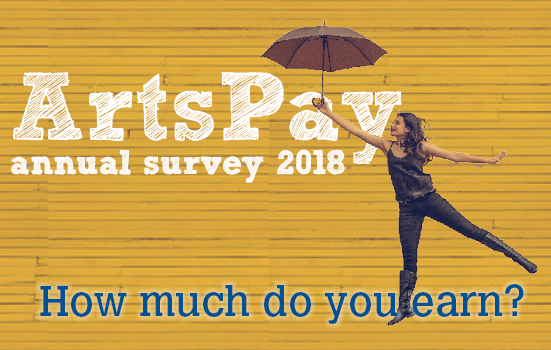
Research to track pay in the cultural sector
Employees, freelance workers, artists and business owner-managers are being encouraged to contribute to ArtsPay, the first annual survey of earnings.
An annual survey tracking levels of pay and earnings in the arts and cultural sector is launched today, aiming to shed light on the financial realities facing those working in and with the sector.
Aimed at employees, freelance workers, artists and business owner-managers involved with the sector, the ArtsPay survey is part of a long-term research programme.
The survey will be repeated each year and the 2018 findings will form the baseline against which future pay and earnings trends will be measured.
Barriers
The research is part of ArtsProfessional’s ongoing commitment to sharing information that will help spread good practice in the sector and draw attention to issues of concern.
Editor Liz Hill explained: “Pay in the arts and cultural sector is notoriously low, but few attempts have been made to document this. As a result it is difficult to see what needs to be done to create a more level playing field with other industries and sectors that are competing in the labour market for talented staff.
“Also, while other research has focused on key barriers to entry into the sector, such as unpaid internships and social class bias, little has been done to examine the financial implications of career advancement within the sector.
“Opportunities for financial progression have a major impact on staff retention and losing experienced staff to other sectors because of low pay is both costly and wasteful. We hope the findings from this survey will give cultural organisations the information they need to help them set appropriate levels of pay that will attract the best candidates for their jobs and retain key staff.”
Evidence
The survey findings will provide evidence in a range of areas, including:
- average pay levels for different jobs in the sector
- how salaries relate to seniority
- demographics facing pay discrimination
- the range of fees charged by freelance workers.
As well as being of value to organisations and policy-makers, the findings will give individuals a benchmark against which to measure their own pay, understand where it fits into the wider sector, and see how they can expect it to progress as they take on more senior roles.
Responses
A significant number of respondents will be required in order to draw an accurate picture, and Hill hopes that the response rate will be high.
She said: “The more people who respond to this survey, the more likely it is that we will have sufficient data to draw robust conclusions about pay and earnings among the many sub-groups represented in the sector as a whole.
“For example, gender, social class and ethnicity are all widely recognised as being factors that influence pay inequality, and this survey aims to show their impact. If sufficient numbers of people respond to the survey, that will be possible. I encourage everyone to share the link to the survey with as many colleagues as possible.”
Developments
ArtsProfessional has conducted two previous pay surveys, in 2006 and again in 2015.
The first survey identified a significant gender pay gap, with progression into senior roles favouring men. Nine years later, it was found that the gender pay gap had widened.
AP hopes that conducting the survey annually will provide the level of evidence needed to bring about a more equal and diverse workforce in the sector.
Hill said: “Poor pay in the arts is the elephant in the room. Everyone knows that budgets are tight in the sector and people accept this as the norm. But because it’s socially unacceptable to discuss pay, and discussions on employees’ pay are held in private, the full implications of pay practices aren’t fully understood.
“We are making a commitment to this long-term research programme in the hope that shedding light on current practice will lead to fairer and more effective remuneration policies from which all will benefit.”
Join the Discussion
You must be logged in to post a comment.